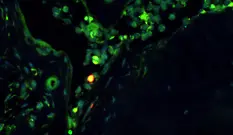Cancer stem cells are considered to be the most dangerous types of cells in a tumor: Not only do they give rise to a tumor, they provide a constant supply of new cancer cells to help the tumor survive. Scientists suspect that the direct offspring of these cells have a unique capacity to break away from a solid tumor in one tissue and spread to form dreaded metastases in other parts of the body. Unfortunately, these cells are not very sensitive to conventional forms of chemotherapy or radiotherapy. They are therefore regarded as the main culprits that cause cancer to recur after treatments that initially appear to be successful.
“We are convinced that we can only overcome cancer if we manage to track it to its roots and eradicate cancer stem cells," says Prof. Dr. Dr. h.c. Otmar Wiestler, Chairman of the Management Board and Scientific Director of the DKFZ, and initiator of the stem cell conferences at the Center. “We are very pleased about the extraordinary resonance to our conference, which has already been ‘fully booked’ for several weeks."
Another researcher whose work has begun to focus on the stem cell niche is conference co-organizer Professor Andreas Trumpp, head of DKFZ’s Division of Stem Cells and Cancer and Managing Director of the Heidelberg Institute for Stem Cell Technology and Experimental Medicine (HI-STEM) of the DKFZ and the Dietmar Hopp Foundation. “Niche cells surround cancer stem cells and support them as they trigger processes that are ultimately fatal. It is therefore vital to keep an eye on niche cells in our efforts to find new approaches in cancer treatment."
A team led by Dr. Haikun Liu of the DKFZ has recently achieved the first positive results on the road toward specifically blocking stem cells responsible for brain cancer. A key step was the group’s identification of a protein called Tlx that seemed to be uniquely active in the cancer stem cells of brain tumors. Switching off Tlx in mice with tumors led to cancer stem cells which lost their ability to renew themselves and a longer survival time for animals with the disease. “Highly humans have properties resembling those of the brain tumors we studied in mice. Human tumor stem cells also produce Tlx, making the protein a new target in combatting these highly aggressive cells. We hope that interfering with its functions will help us check the growth of aggressive brain tumors in humans."
The organizers from the German Cancer Research Center and the German Consortium for Translational Cancer Research (DKTK), the U.S. National Cancer Institute and the National Academy of Sciences Leopoldina invited an elite cast of prominent international stem cell researchers to the conference. John Dick of the University of Toronto is credited with the first identification of cancer stem cells. He reported on the discomforting finding that nearly everyone hosts the precursors of cancer stem cells in their bodies. His Canadian team discovered such “pre-leukemic" stem cells in the bone marrow of healthy study subjects. Elaine Fuchs of Rockefeller University in New York City investigates when and how skin stem cells leave their normal path of development to become cancer stem cells. Frederic de Sauvage, of Genentech Incorporated in San Francisco, California, showed spectacular results from trials of a first drug that specifically targets skin cancer cells. Mina Bissell of the University of California in Berkeley is studying the micro-environment of breast cancer cells, which she is convinced plays an important role in the development of metastases.
“We are also particularly pleased that the conference gives our young researchers an opportunity to talk to stars of stem cell research during the ‘Speakers’ Lunch’," says Wiestler. “We are convinced that this field of research will play an ever more important role in cancer research in the future."
